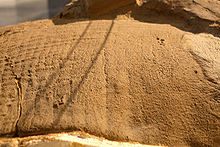- Dakota (fossil)
-
Dakota is the nickname given to a fossil Edmontosaurus from the Hell Creek Formation in North Dakota. It is about 67 million years old,[1] placing it in the Maastrichtian, the last stage of the Cretaceous period. It was about 11 m (35 ft) long and weighed about 3.5 tons[vague].[1]
The fossil is unusual and scientifically valuable because soft tissue including skin and muscle have been fossilized, giving researchers the rare opportunity to study more than bones, as with most vertebrate fossils. Preliminary research results indicate that hadrosaurs had heavier tails and were able to run faster than was previously thought.
Preservation
Dinosaur fossils with Dakota's degree of preservation are extremely rare because many different factors must come together to allow it to occur. The carcass first must escape scavengers as well as degradation by the elements. The soft tissue must then be mineralized before it decomposes. Finally, as with all fossils, the mineralized body must escape destruction by geological forces over millions of years.[1]
News reports have referred to Dakota as "mummified"; however, it is actually a fossil of a mummified dinosaur, where the animal's dried tissues have been transformed to rock through fossilization.[2]
Discovery and analysis
Dakota was first discovered by paleontology student Tyler Lyson on his family's North Dakota property in 1999 while he was a high school student, but he did not investigate the site in detail until 2004, when he discovered the soft tissue preservation. Lyson teamed with British paleontologist Phillip Manning, and the site was excavated in summer 2006.[2]
Manning's team used a large-scale CT scanner, provided by NASA and the Boeing Company, to generate high-resolution scans of the preserved muscles and tendons of the rear legs. Because the intervertebral discs which space out the spinal column of the tail have been fossilized, researchers have been able to calculate its length more accurately. The preservation of its muscles and tendons allow the calculation of its mass. The results indicate the dinosaur could likely have run at 45 km/h (28 mph), faster than the estimated top speed of Tyrannosaurus rex, at 32 km/h (20 mph).[1]
The well-preserved integument has retained its texture, and researchers have mapped it in three dimensions. The scales are of different sizes, and researchers speculate that their pattern may reflect the animal's coloration in life. For example, areas of an arm's joints are textured in what resembles a striped pattern.[1]
This fossil's examination was the subject of a National Geographic documentary, Dino Autopsy.
References
- ^ a b c d e "Mummified Dinosaur Unveiled". National Geographic News. 2007-12-03. http://news.nationalgeographic.com/news/2007/12/photogalleries/dinosaur-pictures/index.html. Retrieved 2007-12-03.
- ^ a b Lee, Christopher (2007-12-03). "Scientists Get Rare Look at Dinosaur Soft Tissue". Washington Post. http://www.washingtonpost.com/wp-dyn/content/story/2007/12/03/ST2007120300591.html. Retrieved 2007-12-03.
Categories:- Cretaceous dinosaurs
- Specific fossil specimens
- Hadrosaurs
- Paleozoology
Wikimedia Foundation. 2010.


